I. The Real Economy - RBI - Reserve Bank of India
I. The Real Economy
The Indian economy recorded robust growth for the third successive year during 2005-06, backed by sustained manufacturing activity and impressive performance of the services sector with reasonable support from the recovery in agricultural activity. After recording some slowdown in the third quarter (October-December) of 2005-06, real gross domestic product (GDP) registered a sharp increase in the fourth quarter (January-March) of 2005-06 benefiting from a pick-up in almost all sub-sectors (Table 1 and Chart 1). According to the revised estimates released by the Central Statistical Organisation (CSO) in May 2006, real GDP accelerated from 7.5 per cent in 2004-05 to 8.4 per cent during 2005-06. The Indian economy has, thus, recorded an average growth of over eight per cent in the latest three years (2003-04 to 2005-06).
| Table 1: Growth Rates of Real GDP |
|||||||||||||||
| (Base Year : 1999-2000) |
|||||||||||||||
| (Per cent) |
|||||||||||||||
| Sector |
2000-01 |
2003- |
2004- |
2005- |
2004-05 |
2005-06 |
|||||||||
| to |
04 |
05* |
06# |
||||||||||||
| Q1 |
Q2 |
Q3 |
Q4 |
Q1 |
Q2 |
Q3 |
Q4 |
||||||||
| 2002-03 |
|||||||||||||||
| (Average) |
|||||||||||||||
| 1 |
2 |
3 |
4 |
5 |
6 |
7 |
8 |
9 |
10 |
11 |
12 |
13 |
|||
| 1. |
Agriculture and |
-0.2 |
10.0 |
0.7 |
3.9 |
3.5 |
-0.2 |
-1.2 |
1.5 |
3.4 |
4.0 |
2.9 |
5.5 |
||
| Allied Activities |
(23.5) |
(22.2) |
(20.8) |
(19.9) |
|||||||||||
| 1.1 Agriculture |
-0.5 |
10.7 |
0.7 |
.. |
|||||||||||
| 2. |
Industry |
5.2 |
6.6 |
7.4 |
7.6 |
6.6 |
8.0 |
8.1 |
6.8 |
9.5 |
6.3 |
7.0 |
7.9 |
||
| (19.7) |
(19.5) |
(19.5) |
(19.3) |
||||||||||||
| 2.1 |
Mining and Quarrying |
4.4 |
5.3 |
5.8 |
0.9 |
8.2 |
6.0 |
5.7 |
3.7 |
3.1 |
-2.6 |
0.0 |
3.0 |
||
| 2.2 |
Manufacturing |
5.7 |
7.1 |
8.1 |
9.0 |
6.6 |
8.3 |
9.2 |
8.1 |
10.7 |
8.1 |
8.3 |
8.9 |
||
| 2.3 |
Electricity, Gas and |
||||||||||||||
| Water Supply |
2.8 |
4.8 |
4.3 |
5.3 |
4.9 |
7.9 |
3.1 |
1.4 |
7.4 |
2.6 |
5.0 |
6.1 |
|||
| 3. Services |
6.6 |
8.5 |
10.2 |
10.3 |
10.0 |
8.2 |
10.6 |
11.6 |
10.1 |
10.3 |
9.7 |
11.0 |
|||
| (56.8) |
(58.3) |
(59.7) |
(60.7) |
||||||||||||
| 3.1 |
Trade, Hotels, Restaurants, |
||||||||||||||
| Transport, Storage |
|||||||||||||||
| and Communication |
8.5 |
12.0 |
9.7 |
11.0 |
10.2 |
12.9 |
10.6 |
11.5 |
10.6 |
11.2 |
11.7 |
11.0 |
|||
| 3.2 |
Financing, Insurance, |
||||||||||||||
| Real Estate and |
|||||||||||||||
| Business Services |
6.5 |
4.5 |
9.2 |
9.7 |
8.8 |
7.5 |
9.7 |
10.7 |
8.8 |
10.5 |
8.9 |
10.5 |
|||
| 3.3 |
Community, Social and |
||||||||||||||
| Personal Services |
4.1 |
5.4 |
9.2 |
7.8 |
10.7 |
4.8 |
8.5 |
12.7 |
7.3 |
8.0 |
8.4 |
7.6 |
|||
| 3.4 |
Construction |
5.9 |
10.9 |
12.5 |
12.1 |
8.9 |
6.8 |
20.8 |
13.5 |
12.4 |
12.3 |
11.5 |
12.0 |
||
| 4. |
Real GDP at Factor Cost |
4.6 |
8.5 |
7.5 |
8.4 |
7.9 |
6.7 |
7.0 |
8.6 |
8.5 |
8.4 |
7.5 |
9.3 |
||
| * : Quick Estimates. #: Revised Estimates. .. : Not available separately. |
|||||||||||||||
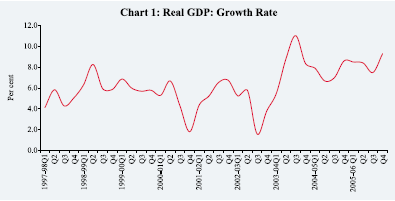
Developments during 2006-07
Against this backdrop of robust economic activity during 2005-06, developments in the various sectors of the Indian economy during 2006-07 so far are covered in this Chapter. These include the progress of the South-West monsoon and kharif sowing, industrial production, lead information on drivers of service sector activity and indicators of business and investment expectations.
Agricultural Situation
The India Meteorological Department (IMD) in its forecast on April 24, 2006 indicated that the rainfall during the South-West monsoon season (June-September) 2006 for the country as a whole is likely to be 93 per cent of the Long Period Average (LPA) with a model error of +/- 5 per cent. In its update on June 30, 2006, the IMD revised its forecast for the 2006 season marginally to 92 per cent of the LPA with a model error of +/- 4 per cent. It also forecast rainfall for the month of July 2006 at 97 per cent of the LPA with a model error of +/-9 per cent.
The monsoon arrived six days in advance - it reached Kerala on May 26, 2006 and covered rapidly the west coast by May 31, 2006 and up to Gujarat by June 2, 2006. Subsequently, the monsoon entered a weak phase and there was a prolonged hiatus in advancement of monsoon for about 17 days. The monsoon revived in the last week of June 2006, and advanced further into other regions. The cumulative rainfall during the South-West monsoon season 2006 so far (June 1 to July 12, 2006) has been 10 per cent below normal as compared with 1 per cent above normal during the comparable period of 2005. Of the 36 meteorological sub-divisions, cumulative rainfall was deficient/scanty/no rain in 9 sub-divisions (8 sub divisions during last year) (Chart 1). At the district level,
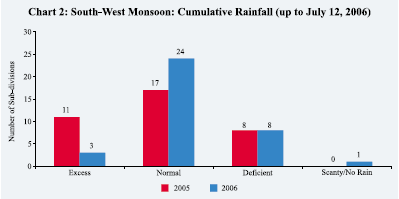
59 per cent of the total number of districts (533) reported excess/normal rainfall, while the rest received deficient/scanty/no rain. The total live water storage in the 76 major reservoirs1 as on July 14, 2006 was 37 per cent of the Full Reservoir Level (FRL), higher than that of 29 per cent a year ago.
The area coverage under kharif crops up to July 10, 2006 was around 11.9 per cent higher than a year ago. For all crops taken together, around 27 per cent of the normal area has been sown so far (Table 2).
| Table 2: Progress of Area under Kharif Crops – 2006-07 |
|||||
| (Million Hectares) |
|||||
| Crop |
Normal Area |
Area Coverage (As on July 10) |
|||
| 2005 |
2006 |
Variation 2006 over 2005 |
|||
| 1 |
2 |
3 |
4 |
5 |
|
| Rice |
39.9 |
5.4 |
6.1 |
0.7 |
|
| Coarse Cereals |
22.9 |
6.8 |
7.3 |
0.5 |
|
| Of which |
|||||
| Bajra |
9.3 |
2.4 |
2.1 |
-0.3 |
|
| Jowar |
4.6 |
1.1 |
1.2 |
0.1 |
|
| Maize |
6.0 |
2.7 |
3.5 |
0.8 |
|
| Total Pulses |
10.6 |
2.0 |
2.7 |
0.7 |
|
| Total Kharif |
Oilseeds |
15.1 |
3.3 |
3.4 |
0.1 |
| Of which |
|||||
| Groundnut |
5.5 |
1.2 |
1.6 |
0.4 |
|
| Soyabean |
6.3 |
1.3 |
1.1 |
-0.2 |
|
| Sesamum |
1.6 |
0.3 |
0.3 |
0.0 |
|
| Sunflower |
0.5 |
0.2 |
0.4 |
0.2 |
|
| Sugarcane |
4.3 |
4.3 |
4.5 |
0.2 |
|
| Cotton |
8.3 |
2.5 |
3.3 |
0.8 |
|
| All Crops |
101.1 |
24.3 |
27.2 |
2.9 |
|
| Source : Ministry of Agriculture, Government of India. |
|||||
1 These reservoirs account for 63 per cent of the total reservoir capacity of the country.
| Table 3: Agricultural Production |
|||||||
| (Million Tonnes) |
|||||||
| Crop |
2003-04 |
2004-05 |
2005-06 |
||||
| T |
A |
T |
A |
T |
A $ |
||
| 1 |
2 |
3 |
4 |
5 |
6 |
7 |
|
| Rice |
87.0 |
88.5 |
93.5 |
83.1 |
87.8 |
91.0 |
|
| Wheat |
72.1 |
72.2 |
79.5 |
68.6 |
75.5 |
69.5 |
|
| Coarse Cereals |
37.8 |
37.6 |
36.8 |
33.5 |
36.5 |
34.7 |
|
| Pulses |
15.2 |
14.9 |
15.3 |
13.1 |
15.2 |
13.1 |
|
| Total Foodgrains |
212.1 |
213.2 |
225.1 |
198.4 |
215.0 |
208.3 |
|
| Kharif |
112.0 |
117.0 |
113.8 |
103.3 |
109.9 |
109.7 |
|
| Rabi |
100.0 |
96.2 |
111.3 |
95.1 |
105.1 |
98.6 |
|
| Total Oilseeds |
25.1 |
25.2 |
26.2 |
24.4 |
26.6 |
27.7 |
|
| Kharif |
17.0 |
16.7 |
16.3 |
14.2 |
16.2 |
16.8 |
|
| Rabi |
8.1 |
8.5 |
9.9 |
10.2 |
10.4 |
10.9 |
|
| Sugarcane |
236.2 |
233.9 |
270.0 |
237.1 |
237.5 |
278.4 |
|
| Cotton # |
13.8 |
13.7 |
15.0 |
16.4 |
16.5 |
19.6 |
|
| Jute and Mesta ## |
11.2 |
11.2 |
11.8 |
10.3 |
11.3 |
10.7 |
|
| T : Target. A : Achievement. |
|||||||
Total foodgrains production during 2005-06 was placed at around 208 million tonnes, an increase of 5.0 per cent over the previous year, mainly on the back of higher output of rice. The increase in the production of non-foodgrains crops was led mainly by sugarcane and cotton (Table 3).
Food Management
Total procurement of rice and wheat during 2006-07 (up to July 4, 2006) at 14.0 million tonnes was 22.1 per cent lower than a year ago. The total offtake of foodgrains (up to April 2006) at 2.8 million tonnes was 18.5 per cent lower than a year ago. While the off-take under the Targeted Public Distribution System (TPDS) was marginally higher, that under Other Welfare Schemes (OWS) was lower than the previous year’s level. The total stock of foodgrains with the Food Corporation of India (FCI) and the State Government agencies was around 22.8 million tonnes as on May 1, 2006, down by 19.9 per cent from a year ago. The stocks were, however, higher than the buffer stock norms (16.2 million tonnes) (Table 4). Both rice and wheat stocks were above the buffer stock norms of 12.2 million tonnes and 4.0 million tonnes, respectively.
Industrial Performance
Industrial production continued with its momentum during April-May 2006 registering growth of 9.8 per cent. The manufacturing sector with double digit growth (10.9 per cent) continued to be the key driver of industrial activity,
| Table 4: Management of Food Stocks |
||||||||||||||
| (Million Tonnes) |
||||||||||||||
| Month |
Opening Stock of |
Procurement of |
Foodgrains Offtake |
Closing |
Norms |
|||||||||
| Foodgrains |
Foodgrains |
Stock |
||||||||||||
| Rice |
Wheat |
Total |
Rice |
Wheat |
Total |
PDS |
OWS |
OMS – |
Exports |
Total |
||||
| Domestic |
||||||||||||||
| 1 |
2 |
3 |
4 |
5 |
6 |
7 |
8 |
9 |
10 |
11 |
12 |
13 |
14 |
|
| 2005 |
||||||||||||||
| January |
12.8 |
8.9 |
21.7 |
3.3 |
0.0 |
3.3 |
2.7 |
0.8 |
0.0 |
0.0 |
3.6 |
21.5 |
16.8 |
|
| February |
14.2 |
7.3 |
21.5 |
2.2 |
0.0 |
2.2 |
2.7 |
0.9 |
0.0 |
0.0 |
3.7 |
20.0 |
||
| March |
13.7 |
5.8 |
20.0 |
1.7 |
0.0 |
1.7 |
2.7 |
1.7 |
0.0 |
0.0 |
4.4 |
18.0 |
||
| April |
13.3 |
4.1 |
18.0 |
1.2 |
12.8 |
14.1 |
2.4 |
1.0 |
0.0 |
0.0 |
3.4 |
28.5 |
16.2 |
|
| May |
13.0 |
15.1 |
28.5 |
1.3 |
1.9 |
3.1 |
2.5 |
0.8 |
0.0 |
0.0 |
3.3 |
27.9 |
||
| June |
11.6 |
15.7 |
27.9 |
0.8 |
0.1 |
0.8 |
2.5 |
1.7 |
0.0 |
0.0 |
4.2 |
25.1 |
||
| July |
10.1 |
14.5 |
25.1 |
0.4 |
0.0 |
0.4 |
2.8 |
0.8 |
0.1 |
0.0 |
3.6 |
21.4 |
26.9 |
|
| August |
8.0 |
13.0 |
21.4 |
0.9 |
0.0 |
0.9 |
2.6 |
0.8 |
0.1 |
0.0 |
3.4 |
18.4 |
||
| September |
6.4 |
11.6 |
18.4 |
0.4 |
0.0 |
0.4 |
2.7 |
0.7 |
0.1 |
0.0 |
3.5 |
15.5 |
||
| October |
4.8 |
10.3 |
15.5 |
7.6 |
0.0 |
7.6 |
2.7 |
0.5 |
0.0 |
0.0 |
3.2 |
19.8 |
16.2 |
|
| November |
10.3 |
9.1 |
19.8 |
2.7 |
0.0 |
2.7 |
2.3 |
0.5 |
0.1 |
0.0 |
2.8 |
19.0 |
||
| December |
11.1 |
7.6 |
19.0 |
3.4 |
0.0 |
3.4 |
2.7 |
0.7 |
0.2 |
0.0 |
3.6 |
19.3 |
||
| 2006 |
||||||||||||||
| January |
12.6 |
6.2 |
19.3 |
3.8 |
0.0 |
3.8 |
2.7 |
0.8 |
0.1 |
0.0 |
3.6 |
19.5 |
20.0 |
|
| February |
14.0 |
4.9 |
19.5 |
2.5 |
0.0 |
2.5 |
2.7 |
0.6 |
0.3 |
0.0 |
3.6 |
18.3 |
||
| March |
14.1 |
3.4 |
18.3 |
1.9 |
0.0 |
1.9 |
2.6 |
0.9 |
0.2 |
0.0 |
3.6 |
16.6 |
||
| April |
13.7 |
2.0 |
16.6 |
1.7 |
8.7 |
10.3 |
2.5 |
0.3 |
0.0 |
0.0 |
2.8 |
22.8 |
16.2 |
|
| May |
12.8 |
9.0 |
22.8 |
1.6 |
0.6 |
2.2 |
N.A. |
N.A. |
N.A. |
N.A. |
N.A. |
N.A. |
||
| June |
N.A. |
N.A. |
N.A. |
1.5 |
0.0 |
1.5 |
N.A. |
N.A. |
N.A. |
N.A. |
N.A. |
N.A. |
||
| July * |
N.A. |
N.A. |
N.A. |
0.1 |
0.0 |
0.1 |
N.A. |
N.A. |
N.A. |
N.A. |
N.A. |
N.A. |
||
| PDS : Public Distribution System. OWS : Other Welfare Schemes. OMS : Open Market Sales. |
||||||||||||||
contributing almost 92.5 per cent of the growth in industry (Chart 3). Electricity and mining sectors, however, continued to exhibit subdued growth.
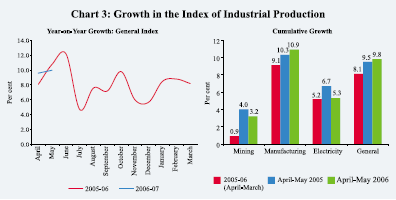
The robust performance of the manufacturing sector was largely led by ‘chemical and chemical products’, ‘machinery and equipments’, ‘basic metal and alloy industries’, ‘transport equipment and parts’, and ‘non-metallic mineral products’ (Table 5). The manufacturing sector growth at 10.9 per cent during April-May 2006 was the highest for this period in the last ten years.
According to the use-based classification, the capital goods sector registered an impressive growth of 21.1 per cent during April-May 2006 even on a high base, reflecting strong investment demand. This is the highest growth for April-May period under the new base (1993-94=100). Higher production of laboratory and scientific instruments, broad gauge passenger carriage, boilers, complete tractors, industrial machinery and textile machinery boosted capital goods production. Basic goods sector was buoyed up by growth in cement sector, carbon steel and other minerals. Intermediate goods sector, after recording subdued growth during most of 2005-06, witnessed moderate improvement, facilitated by higher production of viscose staple fibre, filament yarn, cotton
| Table 5: Growth Rate of Manufacturing Groups |
||||||
| (Per cent) |
||||||
| Industry Group |
Weight in the |
Growth Rate |
Weighted Contribution |
|||
| Index of |
||||||
| April-May |
April-May |
|||||
| Industrial Production |
||||||
| 2005 |
2006 (P) |
2005 |
2006 |
|||
| 1 |
2 |
3 |
4 |
5 |
6 |
|
| 1. |
Chemicals and chemical products |
14.0 |
13.3 |
12.5 |
25.7 |
23.4 |
| except products of petroleum & coal |
||||||
| 2. |
Machinery and equipment other |
9.6 |
11.3 |
13.4 |
16.6 |
18.7 |
| than transport equipment |
||||||
| 3. |
Basic metal and alloy industries |
7.5 |
16.2 |
21.0 |
13.1 |
16.9 |
| 4. |
Transport equipment and parts |
4.0 |
13.6 |
21.4 |
8.4 |
12.8 |
| 5. |
Other manufacturing industries |
2.6 |
9.4 |
31.6 |
3.0 |
9.3 |
| 6. |
Non-metallic mineral products |
4.4 |
7.7 |
12.2 |
5.1 |
7.4 |
| 7. |
Beverages, tobacco and related products |
2.4 |
10.4 |
11.4 |
5.4 |
5.6 |
| 8. |
Rubber, plastic, petroleum and coal products |
5.7 |
2.5 |
8.0 |
1.7 |
4.8 |
| 9. |
Paper and paper products and printing, |
2.7 |
12.5 |
12.1 |
3.9 |
3.7 |
| publishing and allied activities |
||||||
| 10. |
Wool, silk and man-made fibre textiles |
2.3 |
-8.4 |
11.9 |
-3.0 |
3.3 |
| 11. |
Textile products (including wearing apparel) |
2.5 |
25.3 |
9.6 |
7.8 |
3.2 |
| 12. |
Cotton textiles |
5.5 |
9.2 |
2.9 |
3.9 |
1.2 |
| 13. |
Jute and other vegetable fibre textiles (except cotton) |
0.6 |
-3.6 |
-2.8 |
-0.1 |
-0.1 |
| 14. |
Metal products and parts |
2.8 |
6.7 |
-4.1 |
1.7 |
-0.9 |
| (except machinery and equipment) |
||||||
| 15. |
Leather and leather & fur products |
1.1 |
11.4 |
-12.1 |
1.2 |
-1.2 |
| 16. |
Wood and wood products, furniture & fixtures |
2.7 |
-1.3 |
-21.3 |
-0.2 |
-2.4 |
| 17. |
Food products |
9.1 |
7.4 |
-7.6 |
5.8 |
-5.5 |
| Manufacturing – Total |
79.4 |
10.3 |
10.9 |
100.0 |
100.0 |
|
| Source : Central Statistical Organisation. |
||||||
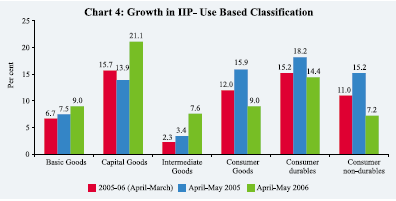
yarn, paints, enamels and varnishes, and PVC pipes and tubes. Consumer goods, both durable and non-durable segments, on the other hand, recorded some deceleration, partly on account of base effect (Chart 4).
Infrastructure
The infrastructure sector recorded growth of 5.9 per cent in April-May 2006 as compared with 7.1 per cent in April-May 2005 on account of deceleration in all industries except petroleum refinery products (Chart 5). Double-digit growth in the petroleum refinery products and moderation in growth of the
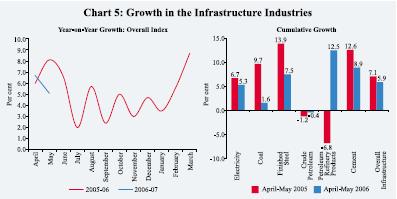
cement and steel sectors could be attributed largely to base effect. The decline in crude oil production resulted from fall in production in plants of ONGC at Mumbai High.
Services Sector
Services sector with double-digit growth during the past two years (2004-05 to 2005-06) has further strengthened its place as the leading sector of the Indian economy. Services sector now accounts for more than 60 per cent of overall GDP. Lead indicators of services sector performance for April-May 2006 suggest continued buoyancy. Revenue earning freight of the railways continued to record strong growth. Substantial activity was witnessed in cargo handled by civil aviation and passengers handled at domestic and international airports. There was a sharp rise in new cell phone connections (Table 6). Healthy growth in bank deposits and non-food credit, and, increased business process outsourcing-information technology enabled services exports are expected to buoy up the sub-sector ‘financing, insurance, real estate and business services’.
Business Expectations Surveys
Various business confidence surveys suggest that economic activity is likely to remain buoyant in the near term (Table 7). The National Council of Applied Economic Research (NCAER) business confidence index (BCI) increased by
| Table 6: Indicators of Service Sector Activity |
||||||
| (Growth rates in per cent) |
||||||
| Sub-sector |
2004-05 |
2005-06 |
April |
|||
| 2005 |
2006 |
|||||
| 1 |
2 |
3 |
4 |
5 |
||
| Tourist arrivals |
23.7 |
11.7 |
19.7 $ |
20.0 $ |
||
| Commercial vehicles production |
28.6 |
10.6 |
-5.3 |
49.7 |
||
| Railway revenue earning freight traffic |
8.1 |
10.7 |
14.9 |
11.0 |
||
| New cell phone connections |
10.4 |
89.4 |
7.6 |
167.0 |
||
| Cargo handled at major ports |
11.3 |
10.3 |
15.8 |
-2.0 |
||
| Civil aviation |
||||||
| a) Export cargo handled |
12.4 |
7.3 |
12.0 |
10.1 |
||
| b) Import cargo handled |
24.2 |
15.8 |
14.6 |
19.9 |
||
| c) Passengers handled at international terminals |
14.0 |
12.8 |
9.9 |
16.2 |
||
| d) Passengers handled at domestic terminals |
23.6 |
27.1 |
19.2 |
54.0 |
||
| Roads: Upgradation of Highways |
16.1 |
-23.4 |
– |
– |
||
| Cement |
8.2 |
10.7 |
12.6 $ |
8.9 $ |
||
| Steel |
7.6 |
6.0 |
13.9 $ |
7.5 $ |
||
| Aggregate deposits |
11.9 |
22.3 |
14.9 @ |
20.7 @ |
||
| Non-food credit |
31.6 |
38.4 |
31.0 @ |
32.9 @ |
||
| Central Government expenditure |
5.6 |
2.2 |
-1.0 $ |
53.9 |
$ |
|
| $ : April-May. |
||||||
| Table 7: Business Expectations Surveys |
||||
| Agency |
Business Expectations |
Growth over |
Growth over |
|
| a year ago |
previous round |
|||
| Period |
Index |
(per cent) |
(per cent) |
|
| Dun & Bradstreet |
2006 (April-June) |
Business Optimism Index |
7.5 |
5.8 |
| NCAER |
2006 (April-September) |
Business Confidence Index |
7.6 |
1.7 |
| FICCI |
2006 (April-September) |
Business Confidence Index |
5.4 |
-1.4 |
| CII |
2006 (April-September) |
Business Confidence Index |
.. |
2.1 |
| RBI |
2006 (July-September) |
Business Expectation Index |
5.8 |
5.0 |
1.7 per cent during April-September 2006 to 154 - the highest level since November 1994. According to the NCAER survey, overall economic conditions and investment climate increased by 2.5 percentage points and 2.2 percentage points, respectively. The CII’s business confidence index for April-September 2006 increased by 2.1 per cent. The BCI was significantly higher for non-manufacturing firms compared to the manufacturing firms. The survey revealed that 88 per cent of the respondents planned to increase investments while 75 per cent of the respondents expected capacity utilisation will be up to 100 per cent. The FICCI’s quarterly Business Confidence Survey conducted during January-March 2006 indicated that the industrial sector was optimistic about sales, selling price, profits, investments, employment and exports. Although the BCI registered a marginal fall from the preceding round partly reflecting the base effect - the BCI had reached an all time high in the previous round - almost 80 per cent of the respondents expected overall economic conditions to be ‘moderately to substantially better’ in the April-September 2006 period. The corporates appear to be comfortably placed in terms of availability and cost of credit. For 89 per cent of the companies, availability of credit was not a constraining factor, while 78 per cent found cost of credit within their affordable limits. The services sector continued to be the most upbeat among the three industry sectors covered in the survey. At the same time, the survey showed that companies are finding rising cost of raw materials as the key challenge to maintain and improve their growth performance.
According to the Reserve Bank’s latest Industrial Outlook Survey, the Business Expectations Index for July-September 2006 quarter increased by 5.0 per cent over the previous quarter’s level (Chart 6). The assessment about the overall business situation for April-June 2006 showed an improvement in the level of confidence over the previous quarter. Responses to the survey suggest an improvement in expectations for the overall business situation, production, capacity utilisation, order books, employment, exports, imports, selling prices and profit margins during the quarter July-September 2006 vis-à-vis April-June 2006. The financial situation is expected to show an improvement during
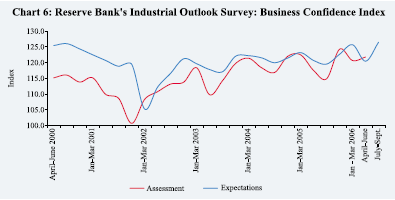
July-September 2006. While working capital finance requirement is expected to increase, the availability of finance is also expected to improve (Table 8).
| Table 8: Net Response on ‘A Quarter Ahead’ Expectations |
|||||||
| About the Industrial Performance |
|||||||
| (Per cent) |
|||||||
| Parameter |
Response |
July- |
Oct- |
Jan- |
Apr- |
June |
|
| Sept |
Dec |
March |
June |
Sept |
|||
| 2005 |
2005 |
2006 |
2006 |
2006 |
|||
| (816) |
(961) |
(934) |
(1086) |
(1073) |
|||
| 1 |
2 |
3 |
4 |
5 |
6 |
7 |
|
| 1. |
Overall business situation |
Better |
45.5 |
51.3 |
49.8 |
46.3 |
53.1 |
| 2. |
Financial situation |
Better |
36.7 |
42.3 |
40.7 |
40.4 |
43.4 |
| 3. |
Working capital finance requirement |
Increase |
28.8 |
32.7 |
31.9 |
30.6 |
32.7 |
| 4. |
Availability of finance |
Improve |
30.7 |
34.1 |
34.1 |
33.8 |
35.0 |
| 5. |
Production |
Increase |
40.7 |
46.9 |
46.3 |
42.5 |
49.4 |
| 6. |
Order books |
Increase |
39.6 |
43.7 |
41.0 |
39.1 |
45.2 |
| 7. |
Cost of raw material |
Decrease |
-43.6 |
-30.0 |
-35.9 |
-37.3 |
-45.8 |
| 8. |
Inventory of raw material |
Below average |
-4.2 |
-6.9 |
-6.8 |
-5.0 |
-6.3 |
| 9. |
Inventory of finished goods |
Below average |
-4.2 |
-3.3 |
-4.7 |
-4.5 |
-2.6 |
| 10. |
Capacity utilization |
Increase |
25.4 |
31.1 |
29.6 |
24.8 |
32.1 |
| 11. |
Level of capacity utilization |
Above normal |
7.6 |
10.9 |
11.4 |
9.4 |
11.8 |
| 12. |
Assessment of production capacity |
More than adequate |
5.3 |
5.0 |
4.9 |
4.1 |
3.6 |
| 13. |
Employment in company |
Increase |
7.8 |
12.7 |
13.3 |
14.5 |
16.4 |
| 14. |
Exports, if applicable |
Increase |
32.5 |
33.3 |
31.8 |
31.0 |
38.3 |
| 15. |
Imports, if any |
Increase |
23.7 |
19.2 |
20.8 |
22.7 |
23.8 |
| 16. |
Selling prices are expected to |
Increase |
13.3 |
7.8 |
10.8 |
12.4 |
16.6 |
| 17. |
If increase expected in selling prices |
Increase at lower rate |
14.0 |
16.6 |
16.3 |
12.0 |
10.5 |
| 18. |
Profit margin |
Increase |
7.1 |
9.6 |
12.6 |
9.3 |
11.1 |
| Note : |
|||||||
The buoyancy in manufacturing and services sector activities and the positive business confidence and expectations suggest that the recent growth momentum in the Indian economy is likely to be maintained in 2006-07, as has also been projected by different agencies (Table 9).
| Table 9: Projections of Real Gross Domestic Product for |
|||||||
| India By Various Agencies: 2006-07 |
|||||||
| Agency |
Growth Projections for 2006-07 (per cent) |
Month of Projections |
|||||
| Overall Growth |
Agriculture |
Industry |
Services |
||||
| 1 |
2 |
3 |
4 |
5 |
6 |
||
| ADB |
7.6 |
– |
– |
– |
April, 2006 |
||
| CDE-DSE |
7.7 |
2.4 |
9.5 |
9.2 |
May, 2006 |
||
| CII |
Around 8.0 |
– |
– |
– |
June, 2006 |
||
| CMIE |
7.9 |
2.5 |
8.5 |
9.6 |
June, 2006 |
||
| ESCAP |
7.9 |
– |
– |
– |
March, 2006 |
||
| ICRA |
7.4-8.2 |
2.0 |
8.2-9.7 |
9.1-9.7 |
January, 2006 |
||
| IMF |
7.3 |
– |
– |
– |
April, 2006 |
||
| Planning Commission* |
7.7 |
3.2 |
8.9 |
8.8 |
December, 2005 |
||
| Reserve Bank of India |
7.5-8.0 |
– |
– |
– |
April, 2006 |
||
| – : Not Available. |
|||||||























